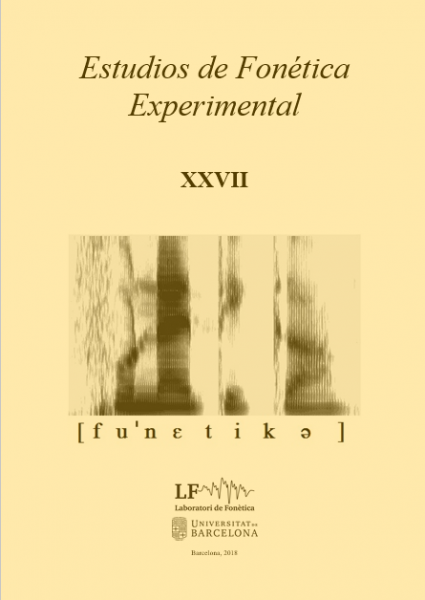Word-initial h aspiration and the presence of the post-velar fricative [χ] in New Mexico Spanish
Keywords:
word-initial h aspiration, New Mexico Spanish, U.S. Spanish, post-velar fricativeAbstract
Researchers first reported the aspiration of word-initial orthographic h (i.e. humo [ˈhu.mo]) in the traditional Spanish of New Mexico over a century ago. Subsequent studies confirmed the presence of this aspiration, but, to date, none have gone into phonetic and spectrographic detail. The current study summarizes some of the synchronic reports of h aspiration, details diachronic explanations given, as well as provides spectrographic analyses of this phenomenon as produced by six speakers of traditional New Mexico Spanish in a guided elicitation speech task. The results reveal that word-initial h aspiration is not only realized as both a glottal fricative [h] and a voiceless velar fricative [x] as previously reported, but also as a voiceless post-velar fricative [χ].
References
BILLS, G. and N. VIGIL (2008): The Spanish Language of New Mexico and southern Colorado: A Linguistic Atlas, Albuquerque, University of New Mexico Press.
BILLS, G. and N. VIGIL (1999): «Ashes to ashes: The historical basis for dialect variation in New Mexican Spanish», Romance Philology, 53, pp. 43-76.
BLAKE, R. (1988): «Sound change and linguistic residue: The case of [f-] > [h-] > [0]», in T. Walsh (ed.): Georgetown University Round Table on Languages and Linguistics, Georgetown, Georgetown University Press, pp. 53-62.
BOERSMA, P. and D. WEENINK (2007): Praat: Doing phonetics by computer, version 4.5.14 http://www.praat.org/ [06/24/2015].
BOWEN, J. D. (1952): The Spanish of San Antonito, New Mexico, Ph.D. dissertation, University of New Mexico.
BROWN, E. K. and M. C. ALBA (2017): «The role of contextual frequency in the articulation of initial /f/ in Modern Spanish: The same effect as in the reduction of Latin /f/?», Language Variation and Change, 29, pp. 57-78.
BROWN, E. L. and W. D. RAYMOND (2012): «How discourse context shapes the lexicon: Explaining the distribution of Spanish f- / h- words», Diachronica, 29, pp. 139-161.
CRADDOCK, J. (2006): «Historia del español en los Estados Unidos», Romance Philology, 60, pp. 199-213.
ESPINOSA, A. M. (1909): «Studies in New Mexican Spanish. Part I: Phonology», Bulletin of the University of New Mexico, Language Series, 1, pp. 1-161.
ESPINOSA, A. M. (1930-1946): Estudios sobre el español de Nuevo Méjico, 2 Vol., Buenos Aires, Facultad de Filosofía y Letras de la Universidad de Buenos Aires.
FILE-MURIEL, R. and E. K. BROWN (2011): «The gradient nature of s-lenition in Caleño Spanish», Language Variation and Change, 23, pp. 223-243.
HAMMOND, R. (2001): The Sounds of Spanish: Analysis and Application, Sommerville, Cascadilla Press.
LADEFOGED, P. (2005): Vowels and Consonants, Malden, Blackwell Publishing.
LAPESA, R. (19819): Historia de la lengua española, Madrid, Editorial Gredos.
LLOYD, P. M. (1987): From Latin to Spanish, Philadelphia, American Philosophical Society.
LOPE BLANCH, J. M. (1987): «El estudio del español hablado en el suroeste de los Estados Unidos», Anuario de Letras, 28, pp. 343-354.
MENÉNDEZ PIDAL, R. (19686): Orígenes del español, Madrid, Espasa-Calpe.
PENNY, R. (1972): «The reemergence of /f/ as a phoneme of Castilian», Zeitschrift für Romanische Philologie, 88, pp. 463-482.
PENNY, R. (1990): «Labiodental -f-, aspiration and -h- dropping in Spanish: The evolving phonemic value of the graphs f and h», in D. Hook and B. Taylor (eds.): Culture in Medieval Spain: Historical and Literary Essays Presented to L. P. Harvey, London, King’s College, pp.157-82.
PENNY, R. (2000): Variation and Change in Spanish, Cambridge, Cambridge University Press.
PIÑEROS, C. E. (2005): «Syllabic-consonant formation in traditional New Mexico Spanish», Probus, 17, pp. 253-301.
QUILIS, A. (19992): Tratado de fonología y fonética españolas, Madrid, Gredos.
RAEL, J. B. (1937): A Study of the Phonology and Morphology of New Mexican Spanish Based on a Collection of 410 Folk-tales, Ph.D. dissertation, Stanford University.
REAL ACADEMIA ESPAÑOLA (2011): Nueva gramática de la lengua española. Fonética y fonología, Barcelona, Espasa Libros.
ROSS, L. D. (1975): La lengua castellana en San Luis, Colorado, Ph.D. dissertation, University of Colorado.
VIGIL, D. (2018): «The rhotics of Taos, New Mexico Spanish: Variation and change», Studies in Hispanic and Lusophone Linguistics, 11, pp. 215-264.
Downloads
Published
How to Cite
Issue
Section
License

This work is licensed under a Creative Commons Attribution-NonCommercial-NoDerivatives 4.0 International License.
All articles published online by Estudios de Fonética Experimental are licensed under Creative Commons Attribution-NonCommercial-NoDerivs 4.0 International (CC BY-NC-ND 4.0 DEED), unless otherwise noted. Estudios de Fonética Experimental is an open access journal. Estudios de Fonética Experimental is hosted by RCUB (Revistes Científiques de la Universitat de Barcelona), powered by Open Journal Systems (OJS) software. The copyright is not transferred to the journal: authors hold the copyright and publishing rights without restrictions. The author is free to use and distribute pre and post-prints versions of his/her article. However, preprint versions are regarded as a work-in-progress version used as internal communication with the authors, and we prefer to share postprint versions.




